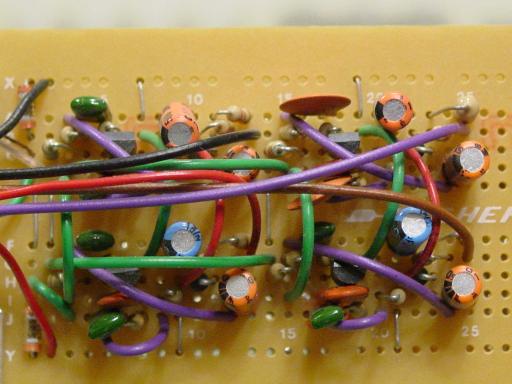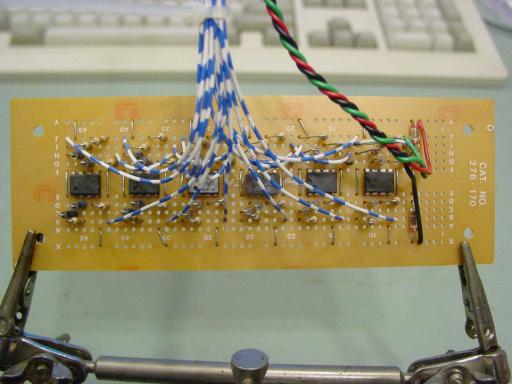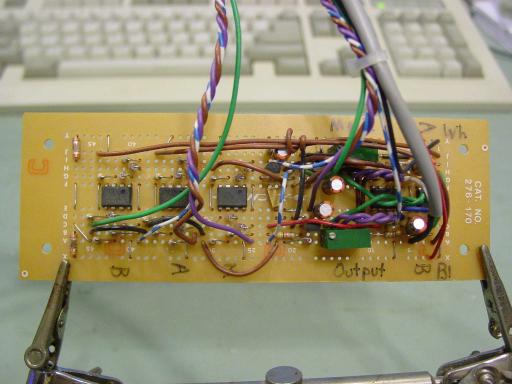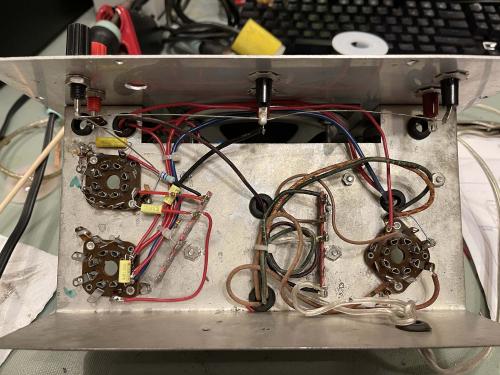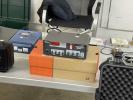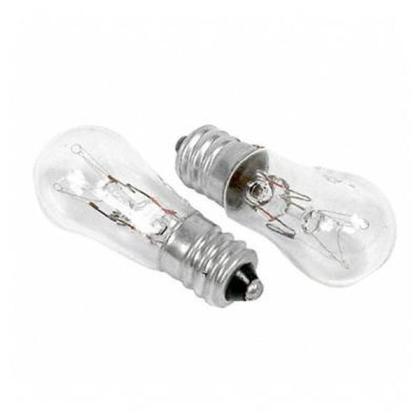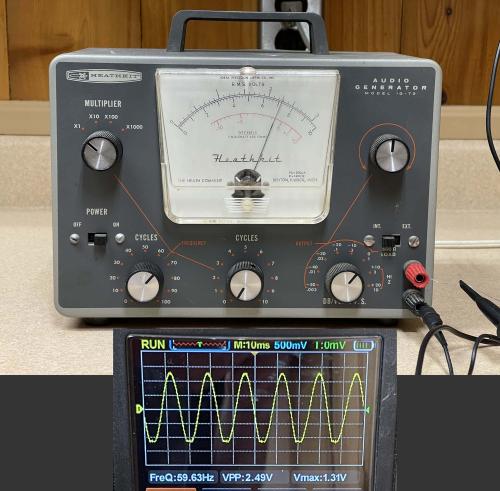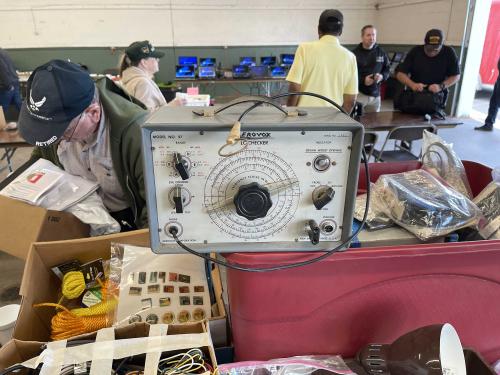- 2024
- Oct
- 10
An audio analyzer project idea from years ago.
A long time ago, I had an idea to make a 10 band audio spectrum analyzer out of meters. I’d use a pre-existing circuit from another device for the band filters, and then rectify it using precision rectifiers. Some other glue circuitry was needed, but I don’t remember everything that was planned for the device.
I couldn’t find enough of the same kind of small meter I wanted to use, so the project got shelved. Eventually, I got rid of the big audio system and no longer had a need for it - but it’s kind of a neat idea and I would still like to complete it. Seeing as how eye tubes are available from overseas sources at a decent price, it may be interesting to revisit this with those instead of meters.
There were four board completed for the project before I didn’t have need for it anymore:
This is the board for the lower 6 bands of a 10 band unit. They’re simple wide-band bandpass filters with a center loosely around the frequency of input. The more eagle-eyed among you may recognize this circuit from that Radio Shack graphic EQ with the multicolor LED display that they sold in the early 90s. It’s right out of the service manual for that device.
This is the board for the upper 4 bands. Same as the lower 6.
This is the lower 6 band precision rectifier. They’re all full-wave bridge rectifiers with an op amp to provide gain for the circuit so that it combats the drop of the diodes. Ge diodes were chosen because of their cheapness (at the time!) and their relatively low voltage drop and fast recovery. This was to provide DC for the meters themselves, which would be directly driven by the output of the op-amps.
1N34 aren’t really cheap these days, but you can still get big packs of them from auction sites relatively cheaply if desired.
I really don’t remember what this board was supposed to do except combine the two inputs at an equal rate. It was going to be doing some other stuff as well, as evidenced by the remaining circuitry - but I can’t remember what that was supposed to be. I’d probably just set this aside and spin up a new precision rectifier and input board if I were to re-start this project.
That’s as far as I got before shelving the unit. I think I’ll revisit this over the winter.
- 2024
- Oct
- 8
An Eico 145 Signal Tracer - Part 6c - I was only going to run a few wires.
I sat down tonight with the intention of tacking in the B+ lines for the transformer and running the filaments. I ended up building half the unit.
I probably didn’t need to use a big terminal strip on the left, but that’s what I had so that’s what I used. I kind of wish I’d picked up more of these years ago from Mendelson’s…
Most of the audio amp is built, I have about 6 parts left to place, the filaments (!), one AC line, and then plumb the audio through the output switch. There’s a couple of layouts that I’m not happy with, but they’re all snug and not going anywhere.
Depending on time, I’ll probably finish this in the next two parts. Stay tuned!
Next part of this series: https://wereboar.com … art-6d-almost-there/
Previous part of this series: https://wereboar.com … ng-the-power-supply/
- 2024
- Oct
- 7
Photos from The Scioto Valley Amateur Radio Club Hamfest 2024
This was a show I’d never been to. It’s certainly a local thing, with a few rows of vendors and a good, but light crowd. Regardless, there was some of that cool stuff you get at shows like this, and I picked up a few books and a boat anchor for my collection of things that hold the floor on the ground. It’s close enough that I’ll probably go next year as well.
Here’s what I saw at the show:
.
On the way home, we stopped at a place I didn’t know still existed - one of the few remaining Rax Restaurants.
Next show is the MARC show at the MAPS hanger near North Canton. See you there!
- 2024
- Oct
- 6
That weird lightbulb in Heathkit - and other - test equipment.
If you’ve ever opened an audio generator from the tube era, chances are you’ve seen one of these in the circuit.
That’s a GE type 11098 - 3S6/5 - a 3W, 115V lamp. It’s used as a balance element for the oscillator in those devices. It acts like a PTC resistor.
The generator I picked up recently at the Piketon Hamfest has a slightly unbalanced output, with the bottom of the signal being flattened. While I assume there are probably some capacitors in there that are bad, it was suggested that I try this lamp. (Maybe…I did find a post where one of these simply needed new tubes and a tune-up.)
They seem to be widely available, as they’re some sort of emergency lighting bulb. I’m planning on ordering some and will give it a try - stay tuned for results!
- 2024
- Oct
- 5
Some notes from The Scioto Valley Amateur Radio Club Hamfest
I grabbed a friend and headed down to this show earlier today. It was a pretty small event, but that’s the kind of thing I like to go to - you never know what you’re going to find. We even stopped at (the last?) Rax on the way home.
I didn’t pick up much - some books, some parts, and this Heathkit Audio generator with a parts donor unit.
I’m asking it for 60Hz, and getting 59.7. That’s pretty good for a piece of 50 year old equipment. It’s a simple capacitive oscillator, so there’s not much to go wrong - exactly what you need for your bench. It’s certainly in need of service, but what do you expect?
Pictures from the event are on the way, so stay tuned!
- 2024
- Oct
- 4
The Aerovox Model 97 Inductor-Capacitor Checker
One of the things I picked up at the Cleveland Hamfest was the Aerovox Model 97 from this picture:
It was cheap, it was from a Silent Key estate that a friend was cleaning up, and it had a functioning eye tube - the primary reason I picked this one up. Those aren’t exactly the easiest thing to come by these days, so having a few laying around is probably a good idea.
This is kind of an oddball unit as far as checkers go - most simply use a pair of leads you put across an unknown part. This one is a bit different in that it has an inductively coupled loop that acts as the probe for the device. You place a coil with probe ends across your part and that couples back to the checker - no direct connections are made, so you save the device if the part is charged.
Unfortunately, the probe coil was not present with the device - it may have been buried somewhere in the box it was stored in, but who knows…I don’t have it, and seeing as how this is a very low capacity device, it doesn’t bother me. Any one of the Eico or Heath devices is a bit more useful in this regard.
It did include a manual, which I will enter into the wereboar archives. You can download a copy here (this link is hosted on my webhost provider’s service):
https://privateemail … 651f/1/8/NDY/NDYvMjE
I’ll be doing an internal photo shoot of this device before it goes into parts storage, so stay tuned!

